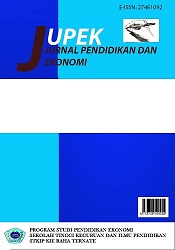COMPARATIVE ANALYSIS OF CUSTOMER SATISFACTION ON TELLER BANK QUEUEING SYSTEM WITH AND WITHOUT NUMBER ON BANK BNI MOROTAI BRANCH
Abstract
This study is intended to compare the two queuing systems, in order to obtain information regarding the highest level of customer satisfaction. The research method used is a comparative descriptive survey research method, which aims to compare and provide an overview of existing facts. The queuing system variables studied are arrivals, queues, and services. Data from 100 questionnaires distributed randomly (simple random sampling) to customers of Bank BNI Morotai Branch became the primary data source. Based on the analysis of the level of customer expectations compared to the actual performance of the queuing system, it can be concluded that there is an increase in customer satisfaction after the replacement of the queuing system, which was initially a queuing system without numbers to a queuing system using numbers. indicates that there is a significant difference between the average level of performance of the queuing system using numbers and the queuing system without numbers. By using comparative analysis, it is known that customers have a higher level of satisfaction in the queuing system using numbers.
Downloads
References
Handi Irawan. 2002. 10 Prinsip Kepuasan Pelanggan. Senayan Abadi Publishing. Jakarta.
Hall, Randolph W. 1991. Queueing Methods : For Services and Manufacturing. Prentice Hall. New Jersey.
Hockenhull, Terence. 2000. Getting the Edge in Professional Selling: Queues, Numbers, and Time Wasting. Business-World. October 24, 1.
Iqbal Hasan. 2002. Pokok-Pokok Materi Metodologi Penelitian & Aplikasinya. Ghalia Indonesia. Jakarta.
Jalaludin Rahmat. 1998. Metode Penelitian Komunikasi. PT. Remaja Rosdakarya. Jakarta.
Kleinrock, Leonard. 1974. Queueing Systems: Volume I Theory. A Wiley-Interscience Publication. New York.
Kotler, Philip. Marketing Management. 2003. Prentice Hall. New Jersey.
Larson, Richard. 1987. Perspective on Queues: Social Justice and the Psychology Of Queuing. Operations Research, 35 (November/December): 895-905.
Levin; Rubin; and Stinson. 1992. Quantitative Approachs To Management, 8th Edition. McGraw-Hill. Singapore.
Lovelock, Christopher and Lauren Wright. 2002. Principles of Service Marketing and Management, 2nd Edition. Pearson Education. New Jersey.
Moh. Nazir. 1999. Metode Penelitian. Ghalia Indonesia
Murti Sumarni. 2002. Manajemen Pemasaran Bank. Liberty Yogyakarta. Yogyakarta
Nirwana Sitepu. 1994. Analisis Regresi dan Korelasi :UPS Statistika. FMIPA UNPAD. Bandung
Schroeder, Roger G. 1997. Manajemen Operasi, Edisi Ketiga. Erlangga. Jakarta.
Sugiyono, dan Wibowo. 2004. Statistika Penelitian. Alfabetha. Bandung.
Syahri Alhusin. 2003. Aplikasi Statistik Praktis Dengan SPSS.10 for Windows. Graha Ilmu. Yogyakarta.
Taha, Hamdy A. 1996. Riset Operasi : Suatu Pengantar, Edisi Kelima, Jilid 2. Binarupa Aksara. Jakarta.
Zhou, Rongrong; Soman, Dilip. 2003. Looking Back: Exploring the Psychology of Queuing and the Effect of the Number of People Behind. Jurnal of Consumer Research, Inc. Vol 29.
Copyright (c) 2023 Jurnal Pendidikan dan Ekonomi (JUPEK)

This work is licensed under a Creative Commons Attribution 4.0 International License.





